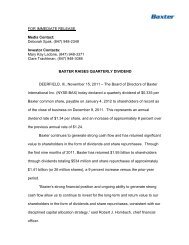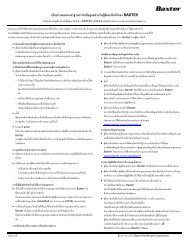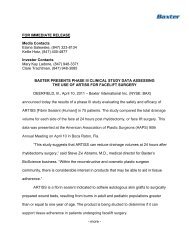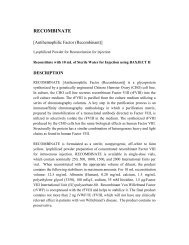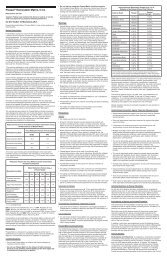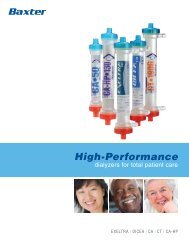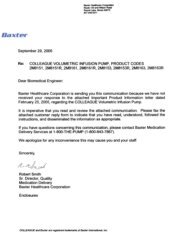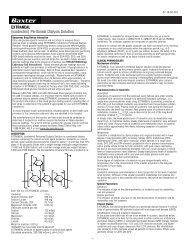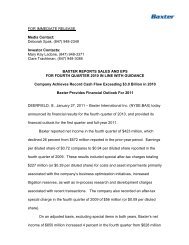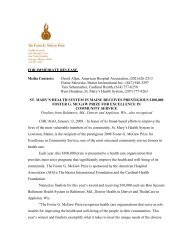FeIBA NF [Anti-Inhibitor Coagulant Complex] - Baxter
FeIBA NF [Anti-Inhibitor Coagulant Complex] - Baxter
FeIBA NF [Anti-Inhibitor Coagulant Complex] - Baxter
You also want an ePaper? Increase the reach of your titles
YUMPU automatically turns print PDFs into web optimized ePapers that Google loves.
<strong>FeIBA</strong> <strong>NF</strong><br />
[<strong>Anti</strong>-<strong>Inhibitor</strong> <strong>Coagulant</strong> <strong>Complex</strong>]<br />
Nanofiltered and Vapor Heated<br />
lyophilized powder for solution<br />
Intravenous<br />
DeSCRIPTIoN<br />
FEIBA <strong>NF</strong> (<strong>Anti</strong>-<strong>Inhibitor</strong> <strong>Coagulant</strong> <strong>Complex</strong>), nanofiltered and vapor heated, is a freeze-dried<br />
sterile human plasma fraction with Factor VIII inhibitor bypassing activity. In vitro, FEIBA <strong>NF</strong><br />
shortens the activated partial thromboplastin time (APTT) of plasma containing Factor VIII<br />
inhibitor. Factor VIII inhibitor bypassing activity is expressed in arbitrary units. One unit of<br />
activity is defined as that amount of FEIBA <strong>NF</strong> that shortens the APTT of a high titer Factor VIII<br />
inhibitor reference plasma to 50% of the blank value.<br />
FEIBA <strong>NF</strong> contains Factors II, IX, and X, mainly non-activated, and Factor VII mainly in the<br />
activated form. The product contains approximately equal unitages of Factor VIII inhibitor<br />
bypassing activity and Prothrombin <strong>Complex</strong> Factors. In addition, 1–6 units of Factor VIII<br />
coagulant antigen (FVIII C:Ag) per mL are present. The preparation contains only traces of<br />
factors of the kinin generating system. It contains no heparin.<br />
Reconstituted FEIBA <strong>NF</strong> contains 4 mg of trisodium citrate and 8 mg of sodium chloride per mL.<br />
FEIBA <strong>NF</strong> is manufactured from large plasma pools of human plasma. Screening against<br />
potentially infectious agents begins with the donor selection process and continues throughout<br />
plasma collection and plasma preparation. Each individual plasma donation used in the<br />
manufacture of FEIBA <strong>NF</strong> is collected only at FDA approved blood establishments and is tested<br />
by FDA licensed serological tests for Hepatitis B Surface <strong>Anti</strong>gen (HBsAg), and for antibodies to<br />
Human Immunodeficiency Virus (HIV-1/HIV-2) and Hepatitis C Virus (HCV) in accordance with<br />
the U.S. regulatory requirements. As an additional safety measure, mini-pools of the plasma are<br />
tested for the presence of HIV-1 and HCV by FDA licensed Nucleic Acid Testing (NAT) and found<br />
negative. In addition, two dedicated and independent virus removal/inactivation steps have<br />
been integrated into the manufacturing process, namely 35 nm nanofiltration and a vapor heat<br />
treatment process. In addition, the DEAE-Sephadex adsorption contributes to the virus safety<br />
profile of FEIBA <strong>NF</strong>. Despite these measures, such products can still potentially transmit disease<br />
(see WARNINGS).<br />
In vitro spiking studies have been used to validate the capability of the manufacturing process<br />
to remove and inactivate viruses. To establish the minimum applicable virus clearance capacity<br />
of the manufacturing process, these virus clearance studies were performed under extreme<br />
conditions (e.g. at minimum incubation times and temperatures below specifications for<br />
vapor-heat treatment). Virus clearance studies for FEIBA <strong>NF</strong> performed in accordance with good<br />
laboratory practices have demonstrated, that the manufacturing process of FEIBA <strong>NF</strong> ensures a<br />
high margin of safety with respect to adventitious viruses (Table 1).<br />
Table 1: Mean log 10 Reduction Factors (RFs) For each Virus and Manufacturing Step<br />
Virus Type enveloped RNA<br />
enveloped<br />
DNA<br />
Nonenveloped<br />
RNA<br />
Nonenveloped<br />
DNA<br />
Virus Family Retroviridae Flaviviridae Herpesviridae Picornaviridae Parvoviridae<br />
Virus* HIV-1 BVDV wNV PRV HAV B19V** MMV<br />
DeAe Sephadex<br />
Adsorption<br />
3.2 1.8 n.d. 2.5 1.5 1.7 1.2<br />
35 nm<br />
Nanofiltration<br />
> 5.3 2.1 4.7 > 5.7 2.6 0.2 † 1.0<br />
Vapor-Heat<br />
Treatment<br />
> 5.9 > 5.6 > 8.1 > 6.7 > 5.2 3.5 0.9 †<br />
overall log<br />
reduction factor<br />
(oRF)<br />
> 14.4 > 9.5<br />
><br />
12.8<br />
> 14.9 > 9.3 5.2 2.2<br />
* Abbreviations: HIV-1, Human Immunodeficiency Virus Type 1; BVDV, Bovine Viral Diarrhea Virus (model for Hepatitis<br />
C Virus and other lipid enveloped RNA viruses); WNV, West Nile Virus; PRV, Pseudorabies Virus (model for lipid<br />
enveloped DNA viruses, including Hepatitis B Virus); HAV, Hepatitis A Virus; MMV, Mice Minute Virus (model for nonlipid<br />
enveloped DNA viruses, including B19 virus [B19V]).<br />
** Reduction factor for Parvovirus B19 claimed for the Vapor Heat Treatment is based on results derived from<br />
experimental infectivity and titration assays.<br />
† Reduction factors < 1 log are not used for calculation of the overall reduction factor; n.d. (not done).<br />
wARNINg<br />
Thrombotic and thromboembolic events have been reported during post-marketing surveillance following infusion of <strong>FeIBA</strong> VH or <strong>FeIBA</strong> <strong>NF</strong>, particularly following<br />
the administration of high doses and/or in patients with thrombotic risk factors (See WARNINGS, PRECAUTIONS and ADVERSE REACTIONS).<br />
ClINICAl STuDIeS<br />
FEIBA <strong>NF</strong> is identical in formulation to FEIBA VH. Biochemical and preclinical studies have<br />
confirmed the comparability of FEIBA <strong>NF</strong> and FEIBA VH.<br />
1, 2<br />
The safety and efficacy of FEIBA has been demonstrated by two prospective clinical trials.<br />
The first, conducted by Sixma and collaborators, was a randomized double-blind study<br />
comparing the effect of FEIBA and PROTHROMPLEX IMMUNO (a non-activated prothrombin<br />
complex concentrate) in 15 patients with hemophilia A and inhibitors to Factor VIII. A total of<br />
150 bleeding episodes (primarily joint and musculoskeletal plus a few mucocutaneous) were<br />
treated. A single dose of 88 Units per kg of body weight was used uniformly for treatments with<br />
FEIBA. The study showed that, based on subjective patient evaluation, FEIBA was fully effective<br />
in 41.0% and partly effective in 24.6% of episodes (i.e. combined effectiveness of 65.6%),<br />
while PROTHROMPLEX IMMUNO was rated fully effective in 25.0% and partly effective in 21.4%<br />
of episodes (i.e. combined effectiveness of 46.4%).<br />
The second study with FEIBA was a multicenter study conducted by Hilgartner et al. 2 This<br />
study was conducted in 44 hemophilia A subjects with inhibitors, 3 hemophilia B subjects with<br />
inhibitors and 2 acquired FVIII inhibitor subjects. It was designed to evaluate the efficacy of<br />
FEIBA in the treatment of joint, mucous membrane, musculocutaneous and emergency bleeding<br />
episodes such as central nervous system hemorrhages and surgical bleedings. In 49 patients<br />
with inhibitor titers of greater than 5 Bethesda Units (from nine co-operating hemophilia<br />
centers), 489 single doses were given for the treatment of 165 bleeding episodes. The usual<br />
dosage was 50 Units per kg of body weight, repeated at 12-hour intervals (6-hour intervals in<br />
mucous membrane bleedings), if necessary. Bleeding was controlled in 153 episodes (93%).<br />
In 130 (78%) of the episodes, hemostasis was achieved with one or more infusions within 36<br />
hours. Of these, 36% were controlled with one infusion within 12 hours. An additional 14% of<br />
episodes responded after more than 36 hours.<br />
Of the 489 single doses, only 18 (3.7%) caused minor transient reactions in recipients. Out of<br />
49 patients, 10 (20%) showed a rise in their inhibitor titers. In 5 of these patients (10%), the<br />
rise was tenfold or more. However, of these 10 patients, 3 had received Factor VIII or Factor IX<br />
concentrates within 2 weeks prior to treatment with FEIBA. These anamnestic rises have not<br />
been observed to interfere with the efficacy of FEIBA.<br />
INDICATIoNS AND uSAge<br />
FEIBA <strong>NF</strong> (<strong>Anti</strong>-<strong>Inhibitor</strong> <strong>Coagulant</strong> <strong>Complex</strong>) is indicated for the control of spontaneous<br />
bleeding episodes or to cover surgical interventions in hemophilia A and hemophilia B patients<br />
with inhibitors.<br />
Clinical experience suggests that patients with a Factor VIII inhibitor titer of less than 5 B.U.<br />
may be successfully treated with <strong>Anti</strong>hemophilic Factor. Patients with titers ranging between<br />
5 and 10 B.U. may either be treated with <strong>Anti</strong>hemophilic Factor or FEIBA <strong>NF</strong>. Cases with Factor<br />
VIII inhibitor titers greater than 10 B.U. have generally been refractory to treatment with<br />
<strong>Anti</strong>hemophilic Factor.<br />
guidelines to First and Second Choice Treatment<br />
Patient’s <strong>Inhibitor</strong> Clinical Situation<br />
Titer Minor Bleeding Major Bleeding Surgery (emergency)<br />
less than 5 B.U. AHF* AHF AHF<br />
5 to 10 B.U.<br />
AHF<br />
FEIBA <strong>NF</strong><br />
AHF<br />
FEIBA <strong>NF</strong><br />
AHF<br />
FEIBA <strong>NF</strong><br />
more than 10 B.U.<br />
* AHF = <strong>Anti</strong>hemophilic Factor<br />
FEIBA <strong>NF</strong> FEIBA <strong>NF</strong> FEIBA <strong>NF</strong><br />
Inadequate response to treatment may result from an abnormal platelet count or impaired platelet<br />
function 3-5 that were present before treatment with FEIBA <strong>NF</strong>, nanofiltered and vapor-heated.
CoNTRAINDICATIoNS<br />
The use of FEIBA <strong>NF</strong> is contraindicated:<br />
• in patients who have known anaphylactic or severe hypersensitivity reactions to the<br />
product.<br />
• in patients who are known to have a normal coagulation mechanism.<br />
• for the treatment of bleeding episodes resulting from coagulation factor deficiencies in<br />
the absence of inhibitors to coagulation factor VIII or coagulation factor IX.<br />
• in patients with significant signs of disseminated intravascular coagulation (DIC).<br />
• in patients with acute thrombosis or embolism (including myocardial infarction).<br />
wARNINgS<br />
At first sign or symptom of an infusion/hypersensitivity reaction or a thrombotic/<br />
thromboembolic event, FEIBA <strong>NF</strong> administration should be stopped immediately and diagnostic<br />
and therapeutic measures initiated as appropriate.<br />
Anaphylaxis and Hypersensitivity Reactions<br />
Allergic-type hypersensitivity reactions, including severe anaphylactoid reactions, have<br />
been reported following the infusion of FEIBA. The symptoms include urticaria, angioedema,<br />
gastrointestinal manifestations, bronchospasm, and hypotension; these reactions can be<br />
severe and can be systemic (e.g., anaphylaxis with urticaria and angioedema, bronchospasm,<br />
and circulatory shock). If signs and symptoms of severe allergic reactions occur, immediately<br />
discontinue administration of FEIBA <strong>NF</strong> and provide appropriate supportive care. Have epinephrine<br />
immediately available to treat, if appropriate, any acute severe hypersensitivity reactions. Other<br />
infusion reactions, such as chills, pyrexia, and hypertension have also been reported.<br />
In patients with known or suspected hypersensitivity to FEIBA <strong>NF</strong>, the expected benefit and the<br />
risk of re-exposure must be carefully weighed, taking into account the known or suspected type<br />
of the patient’s hypersensitivity (allergic or non-allergic), including potential remedial and/or<br />
preventative therapy or alternative therapeutic agents.<br />
Thrombotic and Thromboembolic events<br />
Thrombotic and thromboembolic events [including disseminated intravascular<br />
coagulation (DIC), venous thrombosis, pulmonary embolism, myocardial infarction,<br />
and stroke] have been reported following infusion of <strong>FeIBA</strong> VH or <strong>FeIBA</strong> <strong>NF</strong>, particularly<br />
following the administration of high doses and/or in patients with thrombotic risk factors<br />
(see ADVERSE REACTIONS).<br />
The possible presence of such risk factors should always be considered in patients with<br />
congenital and acquired hemophilia. Thromboembolic events are well recognized potential<br />
complications of FEIBA infusion. Many of these events occurred with doses above 200 units/kg/<br />
day or in patients with other risk factors for thromboembolic events. A single dose of 100 units/<br />
kg body weight and a daily dose of 200 units/kg body weight should not be exceeded unless<br />
the severity of bleeding warrants and justifies the use of higher doses. Patients receiving more<br />
than 100 units/kg of body weight of FEIBA <strong>NF</strong> must be monitored for the development of DIC<br />
and/or symptoms of acute coronary ischemia. High doses of FEIBA <strong>NF</strong> should be given only as<br />
long as absolutely necessary to stop bleeding.<br />
Patients with disseminated intravascular coagulation (DIC), advanced atherosclerotic disease,<br />
crush injury, septicemia, or concomitant treatment with recombinant factor VIIa have an<br />
increased risk of developing thrombotic events due to circulating tissue factor (TF) or<br />
predisposing coagulopathy.<br />
FEIBA VH or FEIBA <strong>NF</strong> should be used with particular caution and only if there are no<br />
therapeutic alternatives in patients at risk of DIC, arterial or venous thrombosis.<br />
FEIBA <strong>NF</strong> should not be given to patients with significant signs of disseminated intravascular<br />
coagulation (DIC) or fibrinolysis. Infusion of FEIBA <strong>NF</strong> should not exceed single dosage of 100<br />
units per kg of body weight and daily doses of 200 units per kg body weight. Thrombotic events<br />
have been identified through post-marketing surveillance following FEIBA use for each of the<br />
approved indications. The incidence of thrombotic events cannot be determined from postmarketing<br />
data.<br />
Transmission of Infectious Agents<br />
FEIBA <strong>NF</strong> (<strong>Anti</strong>-<strong>Inhibitor</strong> <strong>Coagulant</strong> <strong>Complex</strong>), nanofiltered and vapor heated, is made from<br />
human plasma. Because this product is made from human blood, it may carry a risk of transmitting<br />
infectious agents, e.g., viruses, and theoretically, the variant Creutzfeldt-Jakob disease<br />
(vCJD) agent. There is also the possibility that unknown infectious agents may be present in<br />
such products. The risk that such products will transmit viruses has been reduced by screening<br />
plasma donors for prior exposure to certain viruses, by testing for the presence of certain<br />
current virus infections, and by inactivating and removing certain viruses during manufacture.<br />
Despite these measures, such products may still potentially transmit disease.<br />
Record the batch number of the product every time FEIBA <strong>NF</strong> is administered to a patient, and<br />
consider appropriate vaccination (against hepatitis A and B virus) of patients who receive FEIBA <strong>NF</strong>.<br />
ALL infections thought by a physician possibly to have been transmitted by this product<br />
should be reported by the physician or other health care provider to <strong>Baxter</strong> Healthcare<br />
Corporation, at 1-800-423-2862 (in the U.S.) and /or to FDA Med Watch (1-800-FDA-1088 or<br />
www.fda.gov/medwatch).<br />
PReCAuTIoNS<br />
Thrombotic and Thromboembolic Complications<br />
Caution should be used when administering FEIBA VH or FEIBA <strong>NF</strong> to patients with an increased<br />
risk of thromboembolic complications. These include, but are not limited to, patients with<br />
a history of coronary heart disease, liver disease, disseminated intravascular coagulation,<br />
post-operative immobilization, elderly patients and neonates. In each of these situations, the<br />
potential benefit of treatment with FEIBA VH or FEIBA <strong>NF</strong> should be weighed against the risk of<br />
these complications (see WARNINGS: Thrombotic and Thromboembolic Events).<br />
Patients who receive FEIBA VH or FEIBA <strong>NF</strong> should be monitored for development of signs<br />
or symptoms of DIC, acute coronary ischemia, and signs and symptoms of other thrombotic<br />
and thromboembolic events. If clinical signs of intravascular coagulation occur, which include<br />
changes in blood pressure, changes in pulse rate, respiratory distress, chest pain and/or cough,<br />
the infusion should be stopped promptly and appropriate diagnostic and therapeutic measures<br />
are to be initiated.<br />
Laboratory indications of DIC are decreased fibrinogen, decreased platelet count, and/or<br />
presence of fibrin-fibrinogen degradation products (FDP). Other indications of DIC include<br />
significantly prolonged thrombin time, prothrombin time, or partial thromboplastin time.<br />
Concominant Medications<br />
It has been reported that FEIBA <strong>NF</strong> and antifibrinolytics have been given simultaneously without<br />
complications. No adequate and well-controlled studies of the combined or sequential use of<br />
FEIBA <strong>NF</strong> and recombinant Factor VIIa or antifibrinolytics have been conducted. The possibility<br />
of thrombotic events should be considered when systemic antifibrinolytics such as tranexamic<br />
acid and aminocaproic acid are used during treatment with FEIBA <strong>NF</strong>. It is recommended not to<br />
use antifibrinolytics until 12 hours after the administration of FEIBA <strong>NF</strong>.<br />
Discordant Response to Bypassing Agents<br />
Due to patient-specific factors the response to a bypassing agent can vary, and in a given<br />
bleeding situation patients experiencing insufficient response to one agent may respond to<br />
another agent. 6<br />
Anamnestic Responses<br />
Administration of FEIBA <strong>NF</strong> to patients with inhibitors may result in an initial “anamnestic”<br />
rise in inhibitor levels. Anamnestic responses with rise in Factor VIII inhibitor titer have been<br />
observed in 20% of the cases (see CLINICAL STUDIES). These anamnestic rises have not been<br />
observed to interfere with the efficacy of FEIBA. Upon continued administration of FEIBA <strong>NF</strong>,<br />
inhibitors may decrease over time.<br />
Information for Patients<br />
Inform patients receiving <strong>FeIBA</strong> <strong>NF</strong> of the benefits and risks associated with treatment.<br />
Advise patients of the early signs of hypersensitivity reactions (see WARNINGS:<br />
Anaphylaxis and Hypersensitivity Reactions). Advise patients to discontinue use of the<br />
product if these symptoms occur and seek immediate emergency treatment.<br />
Some viruses, such as parvovirus B19 or hepatitis A, are particularly difficult to remove or<br />
inactivate at this time. Pregnant women and immune-compromised individuals should be<br />
informed of the symptoms of parvovirus B19 (i.e. fever, drowsiness, chills, and runny nose<br />
followed about two weeks later by a rash, and joint pain). Inform all patients of the symptoms<br />
of hepatitis A (i.e. several days to weeks of poor appetite, tiredness, and low-grade fever<br />
followed by nausea, vomiting, and upper abdominal pain) infection. Dark urine and a yellowed<br />
complexion are also common symptoms of Hepatitis A infection.<br />
Advise patients/caregivers to record the batch number of the product every time FEIBA <strong>NF</strong> is<br />
administered outside a healthcare setting.<br />
Advise patients to report any adverse reactions or problems following FEIBA <strong>NF</strong> administration<br />
to their physician or healthcare provider.
Non-Hemophilic Patients<br />
Non-hemophilic patients with acquired inhibitors against Factors VIII, IX or XII may have both a<br />
bleeding tendency and an increased risk of thrombosis at the same time.<br />
Monitoring/laboratory Tests<br />
• Perform a platelet count at the time of initial use of the product and if anticipated treatment<br />
responses are not achieved. A sufficient number of functionally intact platelets is considered<br />
to be necessary for the efficacy of the product.<br />
• No direct measure of hemostatic efficacy with bypassing agents is available. Coagulation<br />
tests such as whole blood clotting time (WBCT), aPTT and TEG may not correlate with clinical<br />
improvement. For this reason, attempts at normalizing these values by increasing the dose<br />
of FEIBA <strong>NF</strong> may not be successful and are strongly discouraged because of the potential<br />
hazard of producing DIC by overdose.<br />
Drug Interactions<br />
No compatibility studies have been performed with FEIBA <strong>NF</strong>. Therefore, FEIBA <strong>NF</strong> must not be<br />
mixed with other medicinal products or solvents. (See also Concomitant Medications).<br />
Pregnancy Category C<br />
The safety of FEIBA <strong>NF</strong> during pregnancy has not been established. Animal reproduction studies<br />
have not been conducted with FEIBA <strong>NF</strong>. It is also not known whether FEIBA <strong>NF</strong> can cause fetal<br />
harm when administered to a pregnant woman or can affect reproductive capacity. Physicians<br />
should carefully consider the potential risks and benefits for each specific patient before<br />
prescribing FEIBA <strong>NF</strong>.<br />
Pregnancy and the postpartum period are characterized by an increased risk of thrombosis, and<br />
several complications of pregnancy are associated with an increased risk of DIC.<br />
Nursing Mothers<br />
It is not known whether this drug is excreted in human milk. Because many drugs are excreted in<br />
human milk, caution should be exercised when FEIBA <strong>NF</strong> is administered to a nursing woman.<br />
Physicians should carefully consider the potential risks and benefits for each specific patient<br />
before prescribing FEIBA <strong>NF</strong>.<br />
Pediatric use<br />
No data are available regarding the use of FEIBA <strong>NF</strong> in newborns.<br />
geriatric use<br />
Clinical studies of FEIBA <strong>NF</strong> did not include sufficient numbers of subjects aged 65 and over to<br />
determine whether they respond differently from younger subjects.<br />
ADVeRSe ReACTIoNS<br />
FEIBA <strong>NF</strong> can precipitate allergic-type hypersensitivity reactions; these reactions can be severe<br />
and can be systemic. Other infusion reactions, such as chills, pyrexia, and hypertension have<br />
also been reported.<br />
Adverse Reactions From Clinical Trials<br />
The adverse reactions presented in this section have been reported from two studies with<br />
FEIBA for the treatment of bleeding episodes in pediatric and adult patients with hemophilia<br />
A or B and inhibitors to factors VIII or IX. One study also enrolled acquired hemophilia patients<br />
with factor VIII inhibitors (4 of 49 patients).<br />
Clinical Trial Adverse Reactionsa System organ Class (SoC) Preferred MedDRA Term<br />
Blood and lymphatic system disorders Increase of inhibitor titer (anamnestic response) b<br />
Nervous system disorders Somnolence, Dizziness, Dysgeusia, Hypoesthesia<br />
Respiratory, thoracic, and mediastinal<br />
Dyspnea<br />
disorders<br />
Gastrointestinal disorders Nausea<br />
General disorders and administration site<br />
Chills, Pyrexia, Chest pain, Chest discomfort<br />
conditions<br />
a A precise estimate of the rate of these adverse reactions is not possible from the available data.<br />
b Increase of inhibitor titer (anamnestic response) is the rise of previously existing inhibitor titers occurring after the<br />
administration of FEIBA.<br />
Post-marketing Adverse Reactions<br />
The following adverse reactions have been reported in the post-marketing experience, listed<br />
by MedDRA System Organ Class (SOC), then by Preferred Term in order of severity, where<br />
feasible. Because these reactions are reported voluntarily from a population of uncertain size,<br />
it is not always possible to reliably estimate their frequency or establish a causal relationship<br />
to drug exposure.<br />
BlooD AND lYMPHATIC SYSTeM DISoRDeRS: Disseminated intravascular coagulation.<br />
IMMuNe SYSTeM DISoRDeRS: Anaphylactic reaction, Hypersensitivity.<br />
NeRVouS SYSTeM DISoRDeRS: Paresthesia, Thrombotic stroke, Embolic stroke, Headache.<br />
CARDIAC DISoRDeRS: Myocardial infarction, Tachycardia.<br />
VASCulAR DISoRDeRS: Thrombosis, Venous thrombosis, Arterial thrombosis, Hypotension,<br />
Hypertension, Flushing.<br />
ReSPIRAToRY, THoRACIC, AND MeDIASTINAl DISoRDeRS: Pulmonary embolism, Bronchospasm,<br />
Wheezing, Cough.<br />
gASTRoINTeSTINAl DISoRDeRS: Vomiting, Diarrhea, Abdominal discomfort.<br />
SKIN AND SuBCuTANeouS TISSue DISoRDeRS: Angioedema, Urticaria, Pruritus, Rash.<br />
geNeRAl DISoRDeRS AND ADMINISTRATIoN SITe CoNDITIoNS: Malaise, Feeling hot, Injection site pain.<br />
oVeRDoSAge<br />
The risk of thrombotic and thromboembolic events (including DIC, myocardial infarction, venous<br />
thrombosis, and pulmonary embolism) may be increased with high doses of FEIBA <strong>NF</strong>. Some of<br />
the reported events occurred with doses above 200 U/kg or with patients with other risk factors<br />
for thromboembolic events.<br />
DoSAge AND ADMINISTRATIoN<br />
Treatment should be initiated and supervised by a physician experienced in the management<br />
of hemophilia.<br />
Clinical trials1,2 demonstrated that the response to treatment with FEIBA may differ from patient<br />
to patient with no correlation to the patient’s inhibitor titer. Response may also vary between<br />
different types of hemorrhage (e.g. joint hemorrhage vs. CNS hemorrhage). As a general guideline,<br />
a dosage range of 50 to 100 Units of FEIBA <strong>NF</strong>, per kg of body weight is recommended. However,<br />
care should be taken to distinguish between the following four indications:<br />
Indication<br />
Joint<br />
Hemorrhage<br />
Mucous<br />
Membrane<br />
Bleeding<br />
Soft Tissue<br />
Hemorrhage<br />
(e.g.,<br />
retroperitoneal<br />
bleeding)<br />
Other Severe<br />
Hemorrhage<br />
(e.g., CNS<br />
bleeds)<br />
units/kg<br />
of Body<br />
weight<br />
Dosing guidelines by Type of Hemorrhage<br />
Recommended<br />
Dosing Interval<br />
50–100* 12 hours<br />
50–100* 6 hours<br />
100 12 hours<br />
100 6-12 hours<br />
Additional Information<br />
Continue treatment until clear signs of clinical<br />
improvement appear (e.g., relief of pain, reduction<br />
of swelling or mobilization of the joint).<br />
Two administrations of 100 units/kg a day or<br />
a daily total dose of 200 units/kg should not<br />
normally be exceeded.**<br />
Carefully monitor patient (i.e., examine for<br />
cecessation of visible bleeding) and perform<br />
repeated measurements of the patient’s<br />
hemoglobin/hematocrit.<br />
Two administrations of 100 units/kg a day or a<br />
daily total dose of 200 units/kg should not be<br />
exceeded.**<br />
A daily total dose of 200 units/kg should not be<br />
exceeded.**<br />
May be indicated at 6-hour intervals until clear<br />
clinical improvement is achieved.<br />
Single doses of 100 units/kg body weight and a<br />
daily dose of 200 units/kg body weight should<br />
not be exceeded unless the severity of bleeding<br />
warrants and justifies the use of higher doses.**<br />
* Begin treatment with 50 U/kg. Dose may be increased to 100 units/kg if hemorrage does not stop.<br />
** Patients receiving more than 100 units/kg of body weight of FEIBA <strong>NF</strong> must be monitored for the development of DIC<br />
and/or symptoms of acute coronary ischemia. High doses of FEIBA <strong>NF</strong> should be given only as long as absolutely<br />
necessary to stop bleeding.
Reconstitution<br />
FEIBA <strong>NF</strong> contains no preservatives. Aseptic technique should be used throughout the entire<br />
reconstitution process and the solution should then be used immediately.<br />
1. Allow the unopened vials of FEIBA <strong>NF</strong> (concentrate) and Sterile Fig. A<br />
Water for Injection (diluent) to reach room temperature (not above<br />
37ºC, 98ºF).<br />
2. Remove caps from the concentrate and diluent vials to expose<br />
central portions of the rubber stoppers.<br />
3. Disinfect the rubber stoppers of both vials using a germicidal<br />
solution. Place the vials on an even surface and allow them to dry.<br />
4. Open the package of BAXJECT device by peeling away the lid<br />
without touching the inside (Fig. A).<br />
5. Do not remove the device from the package. Turn the package<br />
over and insert the plastic spike through diluent stopper (Fig. B).<br />
6. Grip the package at its edge and pull the package off the device<br />
(Fig. B).<br />
7. Turn the system over, so that the vial is on top. Quickly insert the<br />
other plastic spike into the FEIBA <strong>NF</strong> stopper (Fig. C). The vacuum<br />
will draw the diluent into the FEIBA <strong>NF</strong> vial. Please make sure<br />
that the connection of the two vials is done expeditiously to<br />
close the open fluid pathway created by the first insertion of<br />
the spike to the diluent vial.<br />
8. Swirl gently until FEIBA <strong>NF</strong> is completely dissolved. Make sure that FEIBA <strong>NF</strong> has been<br />
dissolved completely; otherwise, active material will not pass through the device filter.<br />
Do not refrigerate after reconstitution!<br />
After complete reconstitution of FEIBA <strong>NF</strong> its injection or infusion should be commenced as<br />
promptly as practicable, but must be completed within three hours following reconstitution. The<br />
solution must be given by intravenous injection or intravenous drip infusion.<br />
Rate of Administration:<br />
The maximum injection or infusion rate must not exceed 2 units per kg of body weight<br />
per minute. For a patient with a body weight of 75 kg, this corresponds to an infusion rate of<br />
2.5–7.5 mL per minute depending on the number of units per vial (see label on vial).<br />
Intravenous Injection/Infusion:<br />
• Inspect for particulate matter and discoloration after reconstituting the concentrate as<br />
described under Reconstitution prior to administration. The appearance of the solution<br />
should be colorless to slightly yellowish and essentially free of visible particles. Do not<br />
use solutions that are cloudy or have deposits.<br />
• Mixing of FEIBA <strong>NF</strong> with other products or substances must be<br />
avoided. It is advisable to flush venous access lines with isotonic<br />
saline prior to and after infusion of FEIBA <strong>NF</strong>.<br />
• If devices other than those supplied with FEIBA <strong>NF</strong> are used,<br />
ensure use of an adequate filter.<br />
• Plastic Luer lock syringes are recommended for use with this<br />
product since protein such as FEIBA <strong>NF</strong> tends to stick to the<br />
surface of all-glass syringes.<br />
1. Turn the BAXJECT device handle down towards the FEIBA <strong>NF</strong><br />
concentrate vial and remove the cap attached to the syringe<br />
connection of the BAXJECT device (Fig. D).<br />
2. Draw air into the syringe, connect the syringe to the BAXJECT<br />
device, inject air into the concentrate vial (Fig. E).<br />
3. While keeping the syringe plunger in place, turn the system<br />
upside down (concentrate vial now on top). Draw the<br />
concentrate into the syringe by pulling the plunger back slowly<br />
(Fig. F).<br />
4. Turn the BAXJECT handle to its original position (facing side way).<br />
5. Disconnect the syringe, attach a suitable needle and inject or<br />
infuse intravenously as instructed under Rate of Administration.<br />
Fig. B<br />
Fig. C<br />
Fig. D<br />
Fig. E<br />
Fig. F<br />
How SuPPlIeD<br />
FEIBA <strong>NF</strong> is available in single-dose vials in the following nominal dosage strengths:<br />
Blue 500 Units per vial (NDC 64193-223-02)<br />
Green 1000 Units per vial (NDC 64193-224-02)<br />
Purple 2500 Units per vial (NDC 64193-225-02)<br />
The number of Units of Factor VIII inhibitor bypassing activity is stated on the label of each vial.<br />
FEIBA <strong>NF</strong> is packaged with a suitable volume (20 mL or 50 mL) of Sterile Water for Injection,<br />
U.S.P., one BAXJECT Needleless Transfer Device, and one Package Insert.<br />
The 50 ml SwFI stoppers are not latex-free and may contain Dry Natural Rubber latex.<br />
SToRAge<br />
Store at room temperature, not to exceed 25°C (77°F).<br />
Avoid freezing, which may damage the diluent vial.<br />
Store in the original package in order to protect from light.<br />
ReFeReNCeS<br />
1. Sjamsoedin L. J. M., Heijnen L., Mauser-Bunschoten E. P., van Geijlswijk J. L., van<br />
Houwelingen H., van Asten P., Sixma J. J.: The Effect of Activated Prothrombin-<strong>Complex</strong><br />
Concentrate (FEIBA) on Joint and Muscle Bleeding in Patients with Hemophilia A and<br />
<strong>Anti</strong>bodies to Factor VIII. The New Engl. J. of Med. 305: 717, 1981.<br />
2. Hilgartner M. W., Knatterud G. AND THE FEIBA STUDY GROUP: The Use of Factor-Eight-<br />
<strong>Inhibitor</strong>-By-Passing-Activity (FEIBA IMMUNO) Product for Treatment of Bleeding Episodes in<br />
Hemophiliacs with <strong>Inhibitor</strong>s. Blood 61: 36, 1983.<br />
3. Vermylen J., Schetz J., Semeraro N., Mertens F., Verstraete M.: Evidence that ‘Activated’<br />
Prothrombin Concentrates Enhance Platelet <strong>Coagulant</strong> Activity. Brit. J. Haematol. 38: 235,<br />
1978.<br />
4. Semeraro N., Vermylen J.: Evidence that Washed Human Platelets Possess Factor-X Activator<br />
Activity. Brit. J. Haematol. 36: 107, 1977.<br />
5. Wensley R. T.: General Summary of the Use of FEIBA in Haemophiliacs with <strong>Inhibitor</strong>s to FVIII.<br />
Presentation at the Second Workshop on Factor VIII <strong>Inhibitor</strong> Patients, Vienna, 1979.<br />
6. Astermark, J., Donfield, S.M., DiMichele, D.M., Gringeri, A., Gilbert, S.A., Waters, J. and<br />
Berntorp, E.: A randomized comparison of bypassing agents in haemophilia complicated by<br />
an inhibitor: the FEIBA NovoSeven Comparative (FENOC) Study.: Blood. 109:546, 2007.<br />
To enroll in the confidential, Industry-wide Patient Notification System, call 1-888-UPDATE U<br />
(1-888-873-2838).<br />
<strong>Baxter</strong>, FEIBA and PROTHROMPLEX are trademarks of <strong>Baxter</strong> AG, Vienna, Austria. <strong>Baxter</strong>, FEIBA<br />
and BAXJECT are trademarks of <strong>Baxter</strong> International Inc., registered in the U.S. Patent and<br />
Trademark Office.<br />
<strong>Baxter</strong> Healthcare Corporation<br />
Westlake Village, CA 91362 USA<br />
U.S. License No. 140<br />
Revised: February 2011


![FeIBA NF [Anti-Inhibitor Coagulant Complex] - Baxter](https://img.yumpu.com/2064194/1/500x640/feiba-nf-anti-inhibitor-coagulant-complex-baxter.jpg)
